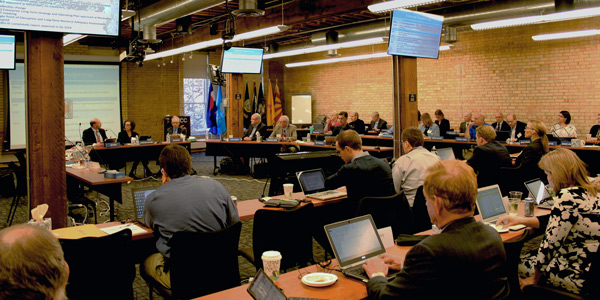By Jason Fordney
SALT LAKE CITY — The Western Electricity Coordinating Council’s board of directors last week endorsed a new three-year operating plan for the organization, part of a larger reinvention intended to more precisely define the organization’s role in protecting electric grid reliability.
The Regional Entity is undergoing a transformation that began with its 2014 restructuring and bifurcation into WECC and Vancouver, Wash.-based Peak Reliability. WECC is the largest and most diverse of NERC’s REs responsible for monitoring and enforcing compliance with reliability standards.
Peak Reliability, which counts utilities, transmission owners and CAISO among its six classes of members, now serves as reliability coordinator for the Western Interconnection, except the Canadian province of Alberta. The organization last week said it is exploring developing a new market structure with a division of PJM. (See PJM Unit to Help Develop Western Markets.)
“Really, [WECC] got kind of refocused on its core reliability assurance mission,” WECC CEO Jim Robb told RTO Insider. The 2018-2020 operating plan endorsed by the board “is really just building a process that wasn’t in place before, recognizing that we have a new kind of board, new management and a new relationship with the members.”
WECC develops and implements reliability standards and regional criteria across 14 Western U.S. states, Alberta, the Canadian province British Columbia and a small, northern portion of Baja California, Mexico. It is a 501(c)(4) “Social Welfare organization” with a current annual budget of $27 million.
Last week Robb detailed the company’s many ongoing initiatives to the board at WECC headquarters, in a modernized former hardware store in downtown Salt Lake City. The discussion illustrated the many complexities in monitoring reliability on an electric grid that is rapidly changing in resource mix and market structure.
A year ago, the WECC board approved five areas of strategic focus for the next three to five years, including focusing on the reliability impacts of new and changing market structures, such as the Western Energy Imbalance Market (EIM) and Mountain West Transmission Group’s effort to join SPP.
Other areas of focus include the reliability impact of changing load and energy resources, identifying and mitigating key vulnerabilities, and analysis of future events that could affect grid reliability that encompassed “high impact, low frequency” events.
What’s in a Name?
WECC has recently revived a proposal to change its name to “Reliability West,” which officials contend would complete the bifurcation efforts begun in 2014 and position the organization as “mission-driven” and “create separation from its history as a Registered Entity,” according to a WECC white paper published last month to tackle issues around the name change, which has been under discussion for three years. The change has many implications regarding implementation costs, perceptions of what the organization does and possible confusion with other entities that share the WECC acronym, the document shows.
“Some folks think this is just a branding effort,” Robb said at the meeting, adding that the proposed name is more reflective of the company’s mission and easier for employees to engage with.
WECC is also drawing up a three-way memorandum of understanding with NERC and the British Columbia Utilities Commission to better define the roles and responsibilities of each organization, and developing a reliability agreement with the Mexico’s Energy Regulatory Commission (CRE). It is also taking comment through Feb. 5 on proposed changes to the operating rules for its Western Renewable Energy Generation Information System (WREGIS).
WECC is funded through allocations to end users in its footprint based on net energy for load, as described in its delegation agreement with NERC. It is not a resource planner, but assesses the reliability implications of resource decisions and identifies concerns to address.
The organization also produces reliability reports on the Western grid. Its June 2017 State of the Interconnection Report showed that, between 2015 and 2016, loss of generation or transmission in the U.S portion of the Western Interconnection increased by 50% to 24 events. (See WECC Generation, Transmission Loss Events Spike.)
In the area of assuring reliability, WECC said its second-quarter index score of reliability outcomes in the Western Interconnection was at or above the average of the past eight quarters, as was the score of indicators of entities building better compliance programs.






